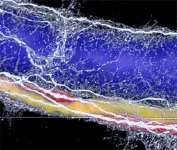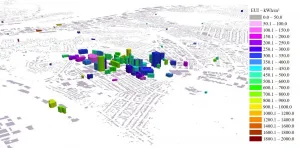(Press-News.org) It's a favourite first-order for the day, but while a quick coffee may perk us up, new research from the University of South Australia shows that too much could be dragging us down, especially when it comes to brain health.
In the largest study of its kind, researchers have found that high coffee consumption is associated with smaller total brain volumes and an increased risk of dementia.
Conducted at UniSA's Australian Centre for Precision Health at SAHMRI and a team of international researchers*, the study assessed the effects of coffee on the brain among 17,702 UK Biobank participants (aged 37-73), finding that those who drank more than six cups of coffee a day had a 53 per cent increased risk of dementia.
Lead researcher and UniSA PhD candidate, Kitty Pham, says the research delivers important insights for public health.
"Coffee is among the most popular drinks in the world. Yet with global consumption being more than nine billion kilograms a year, it's critical that we understand any potential health implications," Pham says.
"This is the most extensive investigation into the connections between coffee, brain volume measurements, the risks of dementia, and the risks of stroke - it's also the largest study to consider volumetric brain imaging data and a wide range of confounding factors.
"Accounting for all possible permutations, we consistently found that higher coffee consumption was significantly associated with reduced brain volume - essentially, drinking more than six cups of coffee a day may be putting you at risk of brain diseases such as dementia and stroke."
Dementia is a degenerative brain condition that affects memory, thinking, behaviour and the ability to perform everyday tasks. About 50 million people are diagnosed with the syndrome worldwide. In Australia, dementia is the second leading cause of death, with an estimated 250 people diagnosed each day.
Stroke is a condition where the blood supply to the brain is disrupted, resulting in oxygen starvation, brain damage and loss of function. Globally, one in four adults over the age of 25 will have a stroke in their lifetime. Data suggests that 13.7 million people will have a stroke this year with 5.5 million dying as a result.
Senior investigator and Director of UniSA's Australian Centre for Precision Health, Professor Elina Hyppönen, says while the news may be a bitter brew for coffee lovers, it's all about finding a balance between what you drink and what's good for your health.
"This research provides vital insights about heavy coffee consumption and brain health, but as with many things in life, moderation is the key," Prof Hyppönen says.
"Together with other genetic evidence and a randomised controlled trial, these data strongly suggest that high coffee consumption can adversely affect brain health. While the exact mechanisms are not known, one simple thing we can do is to keep hydrated and remember to drink a bit of water alongside that cup of coffee.
"Typical daily coffee consumption is somewhere between one and two standard cups of coffee. Of course, while unit measures can vary, a couple of cups of coffee a day is generally fine.
"However, if you're finding that your coffee consumption is heading up toward more than six cups a day, it's about time you rethink your next drink."
INFORMATION:
Notes for editors:
* *International research partners include: Addis Ababa University, Ethiopia; University of Cambridge, England; University of Exeter, England, Alan Turing Institute, England.
* The published paper is available online: Kitty Pham, Anwar Mulugeta, Ang Zhou, John T. O'Brien, David J. Llewellyn & Elina Hyppönen (2021) High coffee consumption, brain volume and risk of dementia and stroke, Nutritional Neuroscience, DOI: 10.1080/1028415X.2021.1945858
Contacts for interview:
Kitty Pham E: Kitty.Pham@unisa.edu.au
Professor Elina Hyppönen: E: Elina.Hypponen@unisa.edu.au
Media contact: Annabel Mansfield M: +61 417 717 504 E: Annabel.Mansfield@unisa.edu.au
Silicon, a semi-metal, bonds in its natural form with four other elements and its three-dimensional structure takes the form of a tetrahedron. For a long time, it seemed impossible to achieve the synthesis and characterisation of a two-dimensional equivalent - geometrically speaking, a square. Now scientists from the field of Inorganic Chemistry at Heidelberg University have succeeded in producing a crystalline complex with such a configuration. PD Dr Lutz Greb from the Institute of Inorganic Chemistry underlines that it has surprising physical and chemical properties and, in the field of molecular chemistry, will open up new approaches to using the second most abundant element in the Earth's crust for catalysis and materials research.
As a classical ...
The touchscreen technology used in billions of smartphones and tablets could also be used as a powerful sensor, without the need for any modifications.
Researchers from the University of Cambridge have demonstrated how a typical touchscreen could be used to identify common ionic contaminants in soil or drinking water by dropping liquid samples on the screen, the first time this has been achieved. The sensitivity of the touchscreen sensor is comparable to typical lab-based equipment, which would make it useful in low-resource settings.
The researchers say their proof of concept could one day be expanded for a wide range of sensing applications, including for biosensing or medical diagnostics, right from the phone in your pocket. The results are reported ...
Many applications, from fiber-optic telecommunications to biomedical imaging processes require substances that emit light in the near-infrared range (NIR). A research team in Switzerland has now developed the first chromium complex that emits light in the coveted, longer wavelength NIR-II range. In the journal Angewandte Chemie, the team has introduced the underlying concept: a drastic change in the electronic structure of the chromium caused by the specially tailored ligands that envelop it.
Many materials that emit NIR light are based on expensive or rare metal complexes. Cheaper alternatives that emit in the NIR-I range between 700 and 950 nm have been developed but NIR-II-emitting complexes of non-precious metals remain extremely rare. Luminescence in the NIR-II range (1000 to 1700 ...
A research team led by Wim Annaert (VIB-KU Leuven) uncovered the early assembly of gamma-secretase, a protein complex linked to numerous cellular processes including the development of Alzheimer's disease. In a first step, two dimeric subcomplexes are formed, which independently exit the ER and only afterwards assemble into a four-subunit complex. This 'buckle up' mechanism is thought to prevent premature assembly and activity. The new insights are very relevant, as gamma-secretase is an important potential therapeutic target for Alzheimer's and other ...
A research team led by Dr Aixin YAN, Associate Professor from the Research Division for Molecular & Cell Biology, Faculty of Science, in collaboration with Honorary Clinical Professor Patrick CY WOO from the Department of Microbiology, Li Ka Shing Faculty of Medicine, the University of Hong Kong (HKU), reported the development of a transferrable and integrative type I CRISPR-based platform that can efficiently edit the diverse clinical isolates of Pseudomonas aeruginosa, a superbug capable of infecting various tissues and organs and a major source of nosocomial infections. The ...
As cities worldwide expand their networks of cycling paths and more cyclists take to the streets, the chances of cycling accidents and potential collisions increase as well, underscoring the need for proper cycling safety in dense urban areas.
According to a World Health Organisation report in 2020, more than 60 per cent of the reported bicycle-related deaths and long-term disabilities are a result of accidents with head injuries.
Researchers from Nanyang Technological University, Singapore (NTU Singapore), in collaboration with French specialty materials leader Arkema, have developed a tougher, safer bicycle helmet using a combination of materials. The new helmet prototype has higher energy absorption, reducing the amount of energy ...
With the application of a novel three-dimensional imaging technology, researchers at Karolinska Institutet in Sweden have discovered that one portion of the autonomic nervous system in the liver undergoes severe degeneration in non-alcoholic fatty liver disease. The study, which is conducted in mice and human liver tissue, shows that the degeneration of nerves is correlated with the severity of liver pathology. The results are being published in the journal Science Advances.
Non-alcoholic fatty liver disease is the most common hepatic disorder, with prevalence around 25 percent globally. Approximately ...
The building sector in the U.S. accounts for 39 percent of energy use, with commercial buildings responsible for about half of that. As cities grapple with climate change, making commercial buildings more efficient is a key part of the solution.
Researchers at the University of Pittsburgh Swanson School of Engineering and the Mascaro Center for Sustainable Innovation used the City of Pittsburgh to create a model built upon the design, materials and purpose of commercial buildings to estimate their energy usage and emissions. While other models may ...
FRANKFURT/HANNOVER. The international team of geoscientists led by Prof. Silke Voigt from the Goethe University Frankfurt, Prof. Ireneusz Walaszczyk from the University of Warsaw and Dr André Bornemann from LBEG have thoroughly investigated 40 metres of the geological strata sequence in the former limestone quarry at Hasselberg. The researchers determined that this is only sequence in the transition between Turonian and Coniacian without gaps and it therefore represents a perfect rock sequence to serve geoscientists from all over the world as a reference for their research - a "Global Stratotype Section and Point (GSSP)" or, in the jargon of geosciences, a "golden nail".
Certain group of bivalve mollusks of the family Inoceramidae, first appeared in the Coniacian, and ...
ORLANDO, July 22, 2021 - Disagreement seems to spread online posts faster and further than agreement, according to a new study from the University of Central Florida.
The finding comes from an examination of posts labeled controversial on social news aggregation site Reddit. To perform the study, the researchers analyzed more than 47,000 posts about cybersecurity in a Reddit dataset that was collected by the Computational Simulation of Online Social Behavior (SocialSim) program of the U.S. Defense Advanced Research Projects Agency.
Researchers found that these posts were seen by nearly twice the number of people and traveled nearly twice as fast when compared ...




